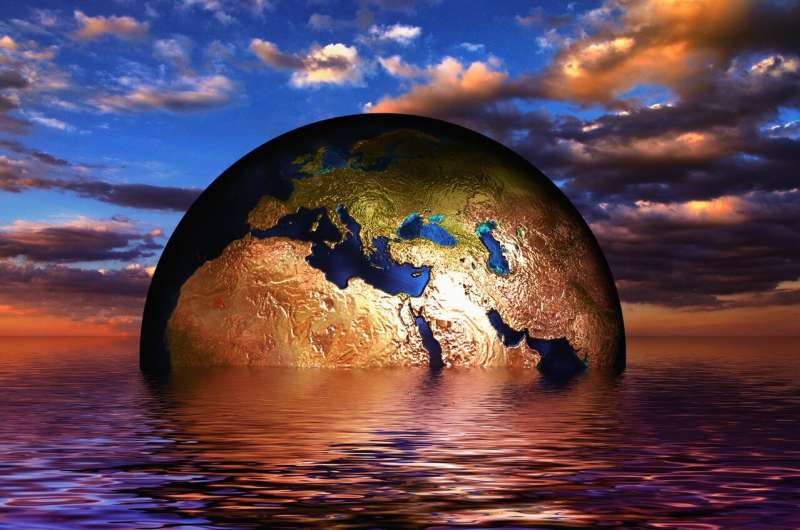Climate change: No reprieve from heat this decade as globally agreed 1.5°C limit looms

Stephanie Baum
scientific editor

Andrew Zinin
lead editor

Temperature limits the world agreed to avoid are looming into view.
The global temperature has been 1.5°C hotter than the pre-industrial average for almost two years now. The reason, overwhelmingly, is that greenhouse gas emissions are at record highs from the burning of fossil fuels and forests.
In a new , the World Meteorological Organization has predicted that global average warming will remain above 1.5°C for the rest of this decade. By some measures, this would place the world nearly halfway to the lower limit of the Paris agreement, which urged countries to avoid warming of 1.5°C as a 20-year average.
Exceeding a globally agreed temperature limit is scary. Perhaps scarier is the speed at which we appear to be breaking our promises.
Half a year of record heat
After 2024 was confirmed as the hottest in 175 years of temperature-keeping, some climate scientists expected 2025 to be cooler. El Niño, the warm phase in the natural cycle of Earth's climate, was subsiding and the cooler La Niña was set to kick in.
This climate fluctuation, centered on the Pacific Ocean, slowly sloshes water and heat between ocean basins every few years and disrupts weather patterns worldwide.
"Typically, by a couple of tenths of a degree Celsius," explains Richard P. Allan, a professor of climate science at the University of Reading. "However, this time around, it's apparently not enough to stop the world warming—even temporarily."
January 2025 was the hottest on record—a whole 1.7°C hotter than an average January before the mass burning of coal, oil and gas. Allan argues that "human-driven ocean warming is increasingly overwhelming these natural climate patterns."
The ocean has absorbed most of the excess heat generated by our emissions, but this blue buffer between us and a hotter atmosphere shows signs of fraying. A research station that has been taking the temperature of the western English Channel for more than 120 years now reports , according to oceanographer Tim Smyth of the Plymouth Marine Laboratory.
A record-hot Atlantic Ocean is bad news for people living in the Caribbean and the southeast of North America. In its latest forecast for the 2025 hurricane season, which begins on June 1, the US National Oceanographic and Atmospheric Administration (NOAA) predicted an number of cyclonic storms.
Much of this elevated risk is due to warmer seawater at the ocean surface fueling stronger storms. But there's only so much that meteorologists can do to stay ahead of the warming climate, as the rapid rate of global heating .
"The rapidly changing climate means we have not necessarily experienced the extremes that modern-day atmospheric and oceanic warmth can produce," say atmospheric scientist Simon H. Lee (University of St Andrews), climate scientist Hayley J. Fowler and meteorologist Paul Davies (both of Newcastle University).
"In a stable climate, scientists would have multiple decades for the atmosphere to get into its various configurations and drive extreme events, such as heat waves, floods or droughts," they say. Scientists typically use weather observations gathered over 30-year periods to characterize the climate.
"But in our rapidly changing climate, we effectively have only a few years—not enough to experience everything the climate has to offer."
How hot will it get?
Compared with its average temperature in the latter half of the 19th century, which is what scientists typically refer to as the climate's pre-industrial baseline, Earth is on track to be 2.7°C hotter by 2100, according to an by leading experts of Earth system science, published in October 2024.
This conclusion is based on governments meeting their emissions goals (a big if) and it may already be out of date, given the unexpectedly hot first half of 2025.
On its own, this charitable estimate projects nearly double the level of warming attained so far. It's unclear if civilization could survive climate conditions like these, which are radically more hostile than anything our ancestors have experienced.
What's behind the accelerating rate of global warming? Here are two of the report authors, ecologists Thomas Newsome of the University of Sydney and William Ripple of Oregon State University.
"Each year, we track 35 of Earth's vital signs, from sea ice extent to forests. [In 2024], 25 are now at record levels, ," they say.
While renewable energy sources like wind and solar have grown rapidly, fossil fuel use remains 14 times greater. What's more, aerosols that are effective at reflecting the sun's energy back into space and cooling Earth (soot is one example) are thought to be falling in the atmosphere.
"Other environmental issues are now feeding into climate change," Newsome and Ripple continue. Deforestation is shrinking the amount of carbon stored on land while rising temperatures and extreme weather are drying out and burning other carbon-rich habitats, like marshes and peatlands.
Sea ice is melting too, ensuring the ocean absorbs yet more of the heat being trapped by an increasingly thick blanket of greenhouse gas.
It is bleak. But how much the planet warms this century is a moving target: Everything we do today, and in coming years, will lower it. On this front, Sven Teske has news—if not good news, then —to share.
"Humanity has shifted track enough to avert the worst climate future," he says.
"Renewables, energy efficiency and other measures have shifted the dial. The worst-case scenario of expanded coal use, soaring emissions and a much hotter world is vanishingly unlikely."
Provided by The Conversation
This article is republished from The Conversation under a Creative Commons license. Read the original article.![]()


















